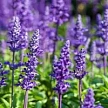
Lavandula
Favorite of perfumers
| Latin name | Lavandula |
| Homeland | The Mediterranean basin |
| Family | Lamiaceae |
| Cultivation | simple |
| Location | in the open sun |
| Temperature | tolerates both low and high values |
| Watering | moderate |
| Flowering time | early spring, summer |
| Height | 0.50-1.2 m |
| Transplanting | not performed |
| Appearance maintenance | remove dried branches |
The genus Lavandula includes 28 semi-shrub and shrubby evergreen species native to the Mediterranean regions. They are small dense bushes with elongated leaves, whole or incised, with an intense aromatic smell. The flowers are small, collected in compact spike-shaped inflorescences with a very pleasant smell. Lavandula spica, an evergreen shrub of summer flowering that can reach 1 m in height, is widely distributed. There are various varieties with white, blue, lilac and purple flowers; there are also dwarf and semi-dwarf varieties. French lavender (L. stoechas) has gray-green leaves and dark purple flowers, reaches a height of 80 cm - just like real lavender (L. vera) with silvery leaves and light blue and white flowers; 'Dwarf white' - very compact in size. The type of lavender intermediate (Lavandula x intermedia) includes many hybrids obtained from crossing broad-leaved lavender (L. latifolia) - a species with elongated leaves and tubular flowers and narrow-leaved lavender (L. angustifolia) - with characteristic lanceolate leaves.
The genus Lavandula includes 28 semi-shrub and shrubby evergreen species native to the Mediterranean regions. They are small dense bushes with elongated leaves, whole or incised, with an intense aromatic smell. The flowers are small, collected in compact spike-shaped inflorescences with a very pleasant smell.
Lavandula spica, an evergreen shrub of summer flowering that can reach 1 m in height, is widely distributed. There are various varieties with white, blue, lilac and purple flowers; there are also dwarf and semi-dwarf varieties.
French lavender (L. stoechas) has gray-green leaves and dark purple flowers, reaches a height of 80 cm - just like real lavender (L. vera) with silvery leaves and light blue and white flowers; 'Dwarf white' - very compact in size.
The type of lavender intermediate (Lavandula x intermedia) includes many hybrids obtained from crossing broad-leaved lavender (L. latifolia) - a species with elongated leaves and tubular flowers and narrow-leaved lavender (L. angustifolia) - with characteristic lanceolate leaves.
Cultivation
Lavender is used in gardens, borders and hedges. The best time for permanent planting is in the fall, but this operation can also be performed in March. The ground should be carefully prepared, quite light, without excess moisture. Faded shoots are pruned to encourage new branching, and hedges are shortened in late winter.
Location
The plant should be placed in a well-lit place to encourage lush, even development.
Temperature
Lavender is a very hardy plant that has no special requirements for temperature conditions.
Watering
High humidity is not required. Watering is only necessary during hot dry periods.
Reproduction
Lavender is one of those plants that is easier to propagate by cuttings; they are taken in the summer from side shoots. If the cuttings are kept in a very moist and well-protected place, planted in a mixture of peat and perlite, they will take root in 2 weeks. Then the seedlings are transplanted into cups filled with peaty soil, which consists of 30% sand; add a full mineral fertilizer at the rate of 30 g per bucket of irrigation water.
Diseases
When lavender is affected by phomosis, the plant is significantly weakened. Honeydew (Armillaria mellea) destroys the plant. Remove affected specimens and disinfect the soil with appropriate fungicides. Some species of gallica provoke bark lag, and the beetle Chrysomela americana, both at the larval and adult stages, destroys the leaves. Treat the plant with insecticides in time.
Acquisition
Usually, plants that have just been transplanted for the first time (repixing) are sold in cups or cellular containers. Make sure that the plants are well developed.